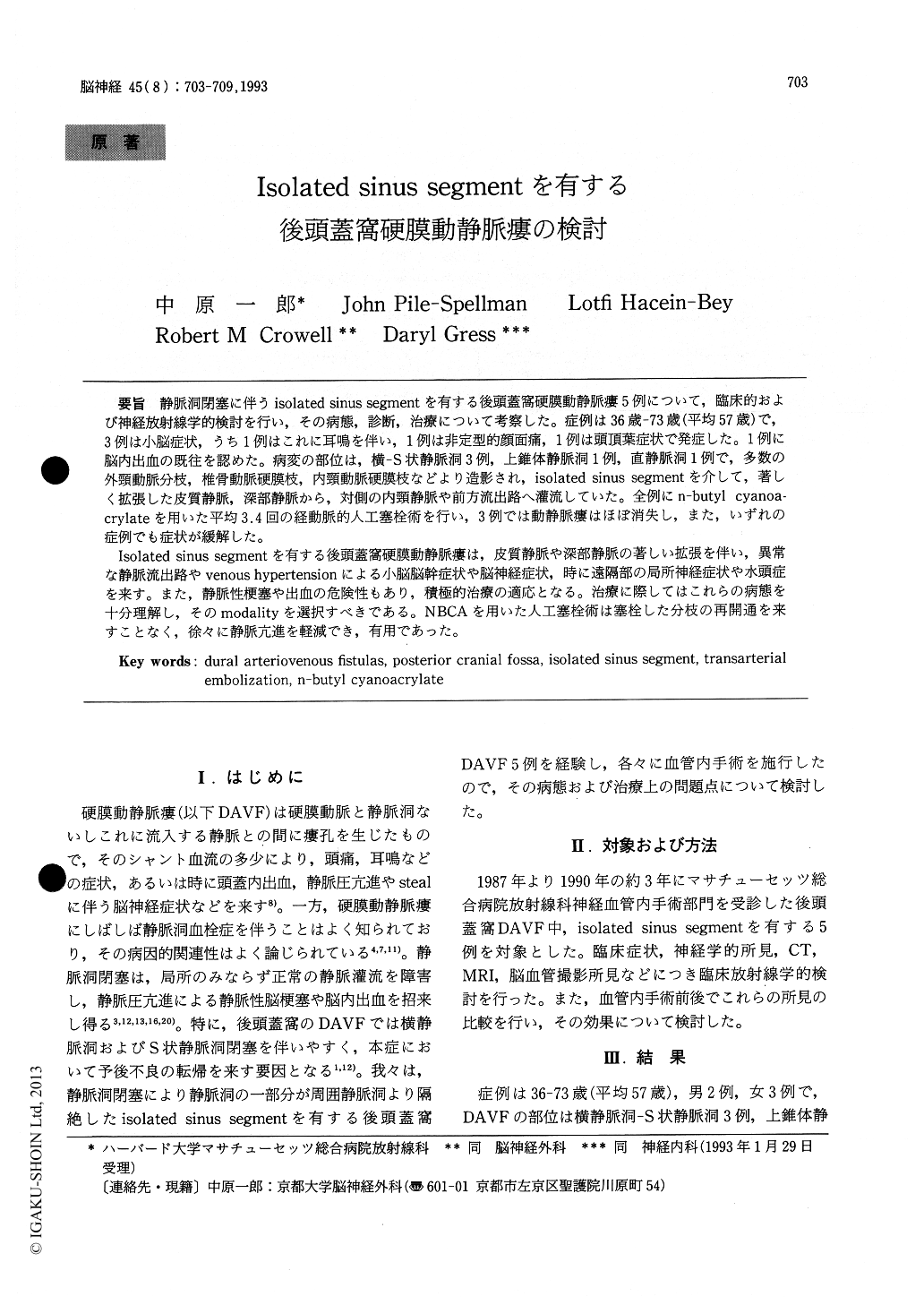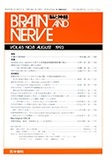Japanese
English
- 有料閲覧
- Abstract 文献概要
- 1ページ目 Look Inside
静脈洞閉塞に伴うisolated sinus segmentを有する後頭蓋窩硬膜動静脈瘻5例について,臨床的および神経放射線学的検討を行い,その病態,診断,治療について考察した。症例は36歳−73歳(平均57歳)で,3例は小脳症状,うち1例はこれに耳鳴を伴い,1例は非定型的顔面痛,1例は頭頂葉症状で発症した。1例に脳内出血の既往を認めた。病変の部位は,横—S状静脈洞3例,上錐体静脈洞1例,直静脈洞1例で,多数の外頸動脈分枝,椎骨動脈硬膜枝,内頸動脈硬膜枝などより造影され,isolated sinus segmentを介して,著しく拡張した皮質静脈,深部静脈から,対側の内頸静脈や前方流出路へ灌流していた。全例にn-butyl cyanoa—crylateを用いた平均3.4回の経動脈的人工塞栓術を行い,3例では動静脈瘻はほぼ消失し,また,いずれの症例でも症状が緩解した。
Isolated sinus segmentを有する後頭蓋窩硬膜動静脈瘻は,皮質静脈や深部静脈の著しい拡張を伴い,異常な静脈流出路やvenous hypertensionによる小脳脳幹症状や脳神経症状,時に遠隔部の局所神経症状や水頭症を来す。また,静脈性梗塞や出血の危険性もあり,積極的治療の適応となる。治療に際してはこれらの病態を十分理解し,そのmodalityを選択すべきである。NBCAを用いた人工塞栓術は塞栓した分枝の再開通を来すことなく,徐々に静脈亢進を軽減でき,有用であった。
Radiological and clinical analysis was performed in 5 patients with posterior fossa dural arterio-venous fistulas (DAVFs) with isolated sinus seg-ment due to sinus thrombosis, and their patho physiological, diagnostic, and therapeutic concerns were discussed. Patients ranged in age from 36 to 73 years old with a mean of 57 years and included 2 males and 3 females. Two patients presented with ataxia, one with ataxia and bruit, one with atypical facial pain, and one with parietal dysfunction. One patient had a history of hemorrhagic event. DAVFs were located at transverse-sigmoid sinus (3 cases), superior petrosal sinus (1 case), and straight sinus (1 case). They were fed by many branches of ex-ternal carotid artery including middle meningeal artery, ascending pharyngeal artery, posterior auri-cular artery, occipital artery, meningeal branches of vertebral artery and posterior cerebral artery, and meningohypophyseal trunk of internal carotid artery. Shunt flow drained into contralateral trans-verse - sigmoid or supratentorial sinuses via the isolated venous segment through markedly dilated cortical and/or deep venous systems, which caused altered normal venous drainage pattern and venous hypertension. Transarterial embolization in multi-ple stages (mean 3.4) using n-butyl cyanoacrylate (NBCA) could alleviate symptoms in all cases. DAVFs were almost totally obliterated in 3 patients. Further embolization in one case, and surgical excision in one case were planed because of some residual dilated cortical venous drainage.
Posterior fossa DAVFs with isolated sinus seg-ment accompany markedly dilated cortical and/or deep venous systems. They could cause cerebellar, brainstem, or cranial nerve dysfunctions, and some-times present distant supratentorial symptoms or hydrocephalus due to abnormal venous drainage and venous hypertension. Also, high risk of intra-cranial hemorrhage justifies the invasive treatment. Staged transarterial embolization using NBCA appeared extremely useful in managing these DAVFs with gradual decrease of venous hyperten-sion without recanalization of the occluded vessel.

Copyright © 1993, Igaku-Shoin Ltd. All rights reserved.


